Photo





Ann Ogbomo as Gault in The Sandman (2022 - )
4K notes
·
View notes
Text
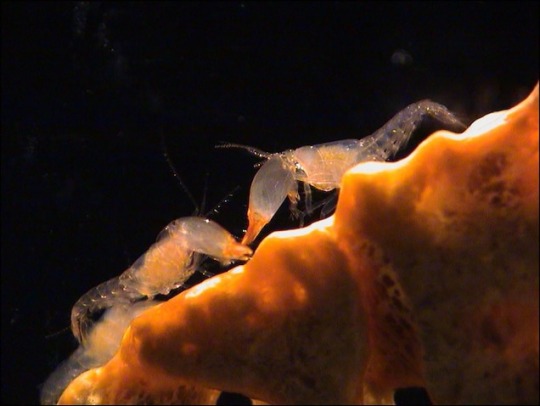



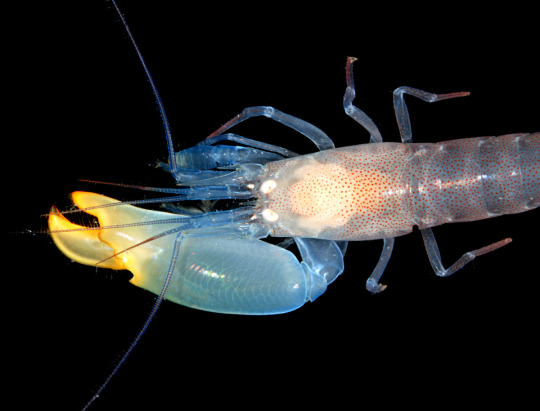
Synalpheus Regalis or Sponge-Dwelling Snapping Shrimp!
On land, we are all familiar with the eusocial behaviors of bees, but did you know that there is one genus of marine creatures that exhibit these same behaviors?
Sponge-dwelling snapping shrimp (aka pistol shrimp) are, according to Nat Geo, the bees of the sea! These tiny shrimp host the inside of sea sponges and live in colonies of about 300 members. The queen will reproduce while the eggs/babies are cared for by the colony. Guard shrimp also protect the queen and the colony from predators. This altruistic behavior exhibited by these shrimp is a strange and beautiful act that is continually being studied by scientists!
385 notes
·
View notes
Text
Game-Changing Sites for Writers
A recent search for a specific type of site to help me build new characters led me down a rabbit hole. Normally, that would make me much less productive, but I have found a treasure trove of websites for writers.
Bring Characters/Places to Life
There are a few different places you can use to create a picture of something entirely new. I love this site for making character pictures as references, instead of stock photos or whatever pops up on Google Images.
thispersondoesnotexist: every time you reload the page, this site generates a headshot of someone who doesn't exist. This is great if you're thinking about a character's personality or age and don't have specifics for their facial features yet.
Night Cafe: this is an AI art generator that takes your text prompt and generates an image for it. I tried it for various scenery, like "forest" or "cottage." It takes a minute for your requested photo to load, but no more than maybe five for the program to finish the picture.
Art Breeder: this website has endless images of people, places, and general things. Users can blend photos to create something new and curious visitors can browse/download those images without creating an account. (But if you do want to make an account to create your own, it's free!)
Find Random Places on Earth
You might prefer to set a story in a real-life environment so you can reference that place's weather, seasons, small-town vibe, or whatever you like. If that's the case, try:
MapCrunch: the homepage generates a new location each day and gives the location/GPS info in the top left of the screen. To see more images from previous days, hit "Gallery" in the top left.
Atlas Obscura: hover over or tap the "Places" tab, then hit "Random Place." A new page will load with a randomly generated location on the planet, provide a Google Maps link, and tell you a little bit about the place.
Random World Cities: this site makes randomly selected lists of global cities. Six appear for each search, although you'll have to look them up to find more information about each place. You can also use the site to have it select countries, US cities or US states too.
Vary Your Wording
Thesauruses are great, but these websites have some pretty cool perspectives on finding just the right words for stories.
Describing Words: tell this website which word you want to stop repeating and it will give you tons of alternative words that mean the same thing. It typically has way more options than other sites I use.
Reverse Dictionary: type what you need a word for in Reverse Dictionary's search box and it will give you tons of words that closely match what you want. It also lists the words in order of relevancy, starting with a word that most accurately describes what you typed. (There's also an option to get definitions for search results!)
Tip of My Tongue: this website is phenomenal. It lets you search for that word you can't quite place by a letter in it, the definition, what it sounds like, or even its scrambled letters. A long list of potential options will appear on the right side of the screen for every search.
---
Hope this helps when you need a hand during your next writing session 💛
9K notes
·
View notes
Text
Boarding
Boarding is when the crew of a ship tries to capture another ship and not sink it by forcing their way on board. Captured ships and captured crew have been a valuable asset to retrieve throughout most of the naval history.
Ancient war galleys, such as those of the Greeks, Romans, Phoenicians and Persians, were armed with heavy ram spurs to pierce the sides of an enemy when the opportunity arose, but they also carried soldiers and archers. But since the opportunity rarely arose, they had to resort to fighting on the enemy deck.

Naval battle between the Romans and Carthaginians, 260 BC.
A ramp (corvus) with long spkies was lowered when the enemy was lying alongside and the men stormed the deck to defeat the enemy as in a land battle.
Fighting as on land and ramming was still very present in the Middle Ages, even if attempts were made to keep distance. As a result, the height of a ship became an important factor that gave the crew the advantage of being able to attack or shoot at the deck of an enemy. Warships began to resemble fortifications on land, with high sides and “castles” built at each end of the hull. The forecastle, which addresses the front part of the ship, dates from this period.

The explosion of the Spanish flagship during the Battle of Gibraltar, 25 April 1607, by Hendrick Vroom 1621
The temptation to build bigger and bigger ships and to load them with heavily armed soliders and archers on the upper deck and different types of cannons distributed all over the ship when they went into battle led to some notoriously unstable ships. This was the case, for example, with Henry VIII’s Mary Rose, which capsized in calm weather and sank in the Solent, as she sailed towards a French assault.
The arrival of heavy cannons on board warships in the early 17th century began to change the way naval warfare was conducted. By the end of the 17th century, naval gunnery had become the main means of fighting an enemy, and small-scale warfare between masses of ships trying to board gave way to fleets in long lines manoeuvring across the sea.
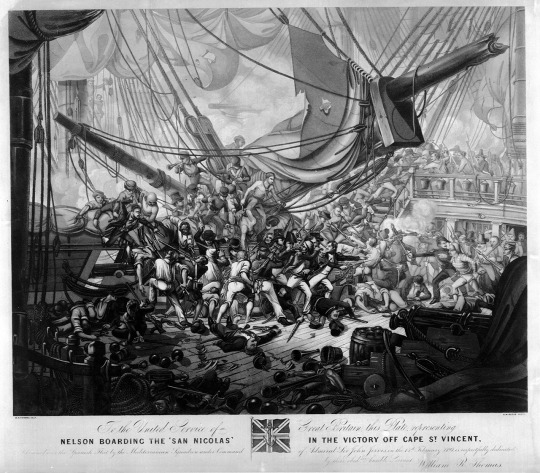
Even though boarding was now used less frequently, it remained a legitimate tactic. All warships trained for both boarding and defence against attackers. When they went into action, they often attached ship-spanning nets to provide a barrier to the enemy. They also carried a large arsenal of weapons for close combat, including muskets, pistols, blunderbusses, cutlasses, boarding axes and pikes. There were even some weapons designed specifically for this type of warfare, such as the strange four-barrel “duck-foot” pistol. All but the smallest warships had marines on board, who were specialists in this kind of warfare. And were often used as sniper in the tops.

Capture of HMS Ambuscade by the French corvette Bayonnaise, 14 December 1798
Under certain circumstances boarding was a preferred tactic. Both privateers and pirates wanted to capture a prize, while causing as little damage to the ship or cargo as possible. It was also the only tactic available during a cutting attack, i.e. when a ship was captured by an enemy approaching in boats alongside.

Even in actions between warships, a protagonist who was in an unequal firefight with a larger enemy could turn the tables with a quick, surprising boarding. Nelson used this tactic to capture the Spanish 80-gun San Nicolás and the 112-gun San Josef with the crew of his much smaller 74-gun captain in the Battle of Cape St. Vincent. In 1798 the French corvette Bayonnaise used the boarding to surprise and defeat the Royal Navy’s larger frigate, Ambuscade. Cochrane did the same in 1801 when he conquered the Spanish 32 guns xebeque El Gamo with his much smaller, 14-gun brig Speedy.
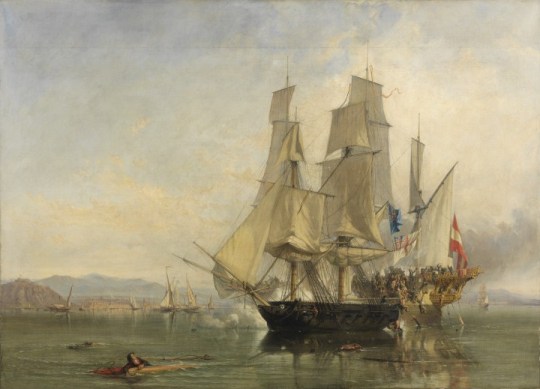
The Action and Capture of the Spanish Xebeque El Gamo, by Clarkson Frederick Stanfield 1845
Smooth bore cannon in the age of sail were only really effective at ranges below a thousand yards, and most battles took place at even closer distances than this, which kept boarding in play as a possible tactic. Even when the introduction of rifled guns in the 19th century pushed out the range at which sea battles took place, crews were still trained in boarding. It was used in situations in which firing at an enemy was not an option. The suppression of the Atlantic slave trade in the 19th century, for example, was largely carried out in this way, for fear of harming the slaves being liberated.
Even if the boarding has changed in its current form, it is still present and is still carried out.
276 notes
·
View notes
Photo

2300 years old Scythian woman’s boot preserved in the frozen ground of the Altai Mountains[750x451]
32K notes
·
View notes
Photo


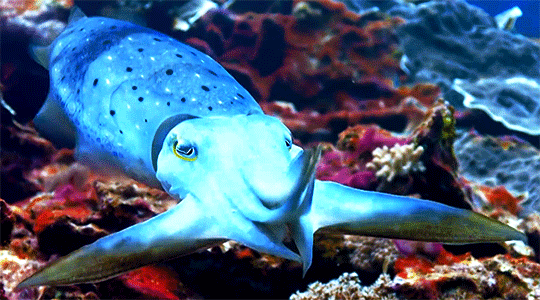
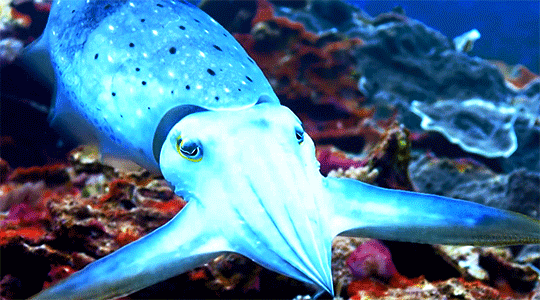

The cuttlefish has a remarkable talent. Its skin contains millions of pigment cells and it uses hypnotic color patterns to mesmerize its prey before it strikes. (Blue Planet II)
34K notes
·
View notes
Text
undefined
tumblr
50K notes
·
View notes
Text
tips for choosing a Chinese name for your OC when you don’t know Chinese
This is a meta for gifset trade with @purple-fury! Maybe you would like to trade something with me? You can PM me if so!
Choosing a Chinese name, if you don’t know a Chinese language, is difficult, but here’s a secret for you: choosing a Chinese name, when you do know a Chinese language, is also difficult. So, my tip #1 is: Relax. Did you know that Actual Chinese People choose shitty names all the dang time? It’s true!!! Just as you, doubtless, have come across people in your daily life in your native language that you think “God, your parents must have been on SOME SHIT when they named you”, the same is true about Chinese people, now and throughout history. If you choose a shitty name, it’s not the end of the world! Your character’s parents now canonically suck at choosing a name. There, we fixed it!
However. Just because you should not drive yourself to the brink of the grave fretting over choosing a Chinese name for a character, neither does that mean you shouldn’t care at all. Especially, tip #2, Never just pick some syllables that vaguely sound Chinese and call it a day. That shit is awful and tbh it’s as inaccurate and racist as saying “ching chong” to mimic the Chinese language. Examples: Cho Chang from Harry Potter, Tenten from Naruto, and most notorious of all, Fu Manchu and his daughter Fah lo Suee (how the F/UCK did he come up with that one).
So where do you begin then? Well, first you need to pick your character’s surname. This is actually not too difficult, because Chinese actually doesn’t have that many surnames in common use. One hundred surnames cover over eighty percent of China’s population, and in local areas especially, certain surnames within that one hundred are absurdly common, like one out of every ten people you meet is surnamed Wang, for example. Also, if you’re making an OC for an established media franchise, you may already have the surname based on who you want your character related to. Finally, if you’re writing an ethnically Chinese character who was born and raised outside of China, you might only want their surname to be Chinese, and give them a given name from the language/culture of their native country; that’s very very common.
If you don’t have a surname in mind, check out the Wikipedia page for the list of common Chinese surnames, roughly the top one hundred. If you’re not going to pick one of the top one hundred surnames, you should have a good reason why. Now you need to choose a romanization system. You’ll note that the Wikipedia list contains variant spellings. If your character is a Chinese-American (or other non-Chinese country) whose ancestors emigrated before the 1950s (or whose ancestors did not come from mainland China), their name will not be spelled according to pinyin. It might be spelled according to Wade-Giles romanization, or according to the name’s pronunciation in other Chinese languages, or according to what the name sounds like in the language of the country they immigrated to. (The latter is where you get spellings like Lee, Young, Woo, and Law.) A huge proportion of emigration especially came from southern China, where people spoke Cantonese, Min, Hakka, and other non-Mandarin languages.
So, for example, if you want to make a Chinese-Canadian character whose paternal source of their surname immigrated to Canada in the 20s, don’t give them the surname Xie, spelled that way, because #1 that spelling didn’t exist when their first generation ancestor left China and #2 their first generation ancestor was unlikely to have come from a part of China where Mandarin was spoken anyway (although still could have! that’s up to you). Instead, name them Tse, Tze, Sia, Chia, or Hsieh.
If you’re working with a character who lives in, or who left or is descended from people who left mainland China in the 1960s or later; or if you’re working with a historical or mythological setting, then you are going to want to use the pinyin romanization. The reason I say that you should use pinyin for historical or mythological settings is because pinyin is now the official or de facto romanization system for international standards in academia, the United Nations, etc. So if you’re writing a story with characters from ancient China, or medieval China, use pinyin, even though not only pinyin, but the Mandarin pronunciations themselves didn’t exist back then. Just… just accept this. This is one of those quirks of having a non-alphabetic language.
(Here’s an “exceptions” paragraph: there are various well known Chinese names that are typically, even now, transliterated in a non-standard way: Confucius, Mencius, the Yangtze River, Sun Yat-sen, etc. Go ahead and use these if you want. And if you really consciously want to make a Cantonese or Hakka or whatever setting, more power to you, but in that case you better be far beyond needing this tutorial and I don’t know why you’re here. Get. Scoot!)
One last point about names that use the ü with the umlaut over it. The umlaut ü is actually pretty critical for the meaning because wherever the ü appears, the consonant preceding it also can be used with u: lu/lü, nu/nü, etc. However, de facto, lots of individual people, media franchises, etc, simply drop the umlaut and write u instead when writing a name in English, such as “Lu Bu” in the Dynasty Warriors franchise in English (it should be written Lü Bu). And to be fair, since tones are also typically dropped in Latin script and are just as critical to the meaning and pronunciation of the original, dropping the umlaut probably doesn’t make much difference. This is kind of a choice you have to make for yourself. Maybe you even want to play with it! Maybe everybody thinks your character’s surname is pronounced “loo as in loo roll” but SURPRISE MOFO it’s actually lü! You could Do Something with that. Also, in contexts where people want to distinguish between u and ü when typing but don’t have easy access to a keyboard method of making the ü, the typical shorthand is the letter v.
Alright! So you have your surname and you know how you want it spelled using the Latin alphabet. Great! What next?
Alright, so, now we get to the hard part: choosing the given name. No, don’t cry, I know baby I know. We can do this. I believe in you.
Here are some premises we’re going to be operating on, and I’m not entirely sure why I made this a numbered list:
Chinese people, generally, love their kids. (Obviously, like in every culture, there are some awful exceptions, and I’ll give one specific example of this later on.)
As part of loving their kids, they want to give them a Good name.
So what makes a name a Good name??? Well, in Chinese culture, the cultural values (which have changed over time) have tended to prioritize things like: education; clan and family; health and beauty; religious devotions of various religions (Buddhism, Taoism, folk religions, Christianity, other); philosophical beliefs (Buddhism, Confucianism, etc) (see also education); refinement and culture (see also education); moral rectitude; and of course many other things as the individual personally finds important. You’ll notice that education is a big one. If you can’t decide on where to start, something related to education, intelligence, wisdom, knowledge, etc, is a bet that can’t go wrong.
Unlike in English speaking cultures (and I’m going to limit myself to English because we’re writing English and good God look at how long this post is already), there is no canon of “names” in Chinese like there has traditionally been in English. No John, Mary, Susan, Jacob, Maxine, William, and other words that are names and only names and which, historically at least, almost everyone was named. Instead, in Chinese culture, you can basically choose any character you want. You can choose one character, or two characters. (More than two characters? No one can live at that speed. Seriously, do not give your character a given name with more than two characters. If you need this tutorial, you don’t know enough to try it.) Congratulations, it is now a name!!
But what this means is that Chinese names aggressively Mean Something in a way that most English names don’t. You know nature names like Rose and Pearl, and Puritan names like Wrestling, Makepeace, Prudence, Silence, Zeal, and Unity? I mean, yeah, you can technically look up that the name Mary comes from a etymological root meaning bitter, but Mary doesn’t mean bitter in the way that Silence means, well, silence. Chinese names are much much more like the latter, because even though there are some characters that are more common as names than as words, the meaning of the name is still far more upfront than English names.
So the meaning of the name is generally a much more direct expression of those Good Values mentioned before. But it gets more complicated!
Being too direct has, across many eras of Chinese history, been considered crude; the very opposite of the education you’re valuing in the first place. Therefore, rather than the Puritan slap you in the face approach where you just name your kid VIRTUE!, Chinese have typically favoured instead more indirect, related words about these virtues and values, or poetic allusions to same. What might seem like a very blunt, concrete name, such as Guan Yu’s “yu” (which means feather), is actually a poetic, referential name to all the things that feathers evoke: flight, freedom, intellectual broadmindness, protection…
So when you’re choosing a name, you start from the value you want to express, then see where looking up related words in a dictionary gets you until you find something that sounds “like a name”; you can also try researching Chinese art symbolism to get more concrete names. Then, here’s my favourite trick, try combining your fake name with several of the most common surnames: 王,李,陈. And Google that shit. If you find Actual Human Beings with that name: congratulations, at least if you did f/uck up, somebody else out there f/ucked up first and stuck a Human Being with it, so you’re still doing better than they are. High five!
You’re going to stick with the same romanization system (or lack thereof) as you’ve used for the surname. In the interests of time, I’m going to focus on pinyin only.
First let’s take a look at some real and actual Chinese names and talk about what they mean, why they might have been chosen, and also some fictional OC names that I’ve come up with that riff off of these actual Chinese names. And then we’ll go over some resources and also some pitfalls. Hopefully you can learn by example! Fun!!!

Let’s start with two great historical strategists: Zhuge Liang and Zhou Yu, and the names I picked for some (fictional) sons of theirs. Then I will be talking about Sun Shangxiang and Guan Yinping, two historical-legendary women of the same era, and what I named their fictional daughters. And finally I’ll be talking about historical Chinese pirate Gan Ning and what I named his fictional wife and fictional daughter. Uh, this could be considered spoilers for my novel Clouds and Rain and associated one-shots in that universe, so you probably want to go and read that work… and its prequels… and leave lots of comments and kudos first and then come back. Don’t worry, I’ll wait.
(I’m just kidding you don’t need to know a thing about my work to find this useful.)

Keep reading
38K notes
·
View notes
Photo







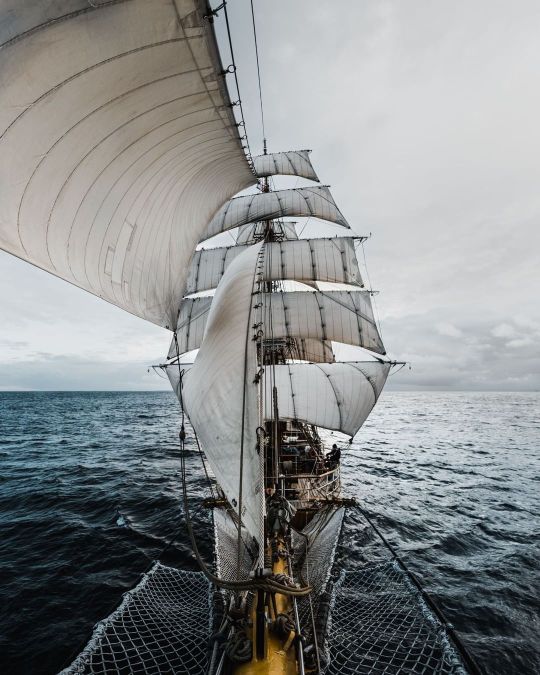


Antarctica Sailing
© Bark Europa
1K notes
·
View notes
Video
Cuttlefish can change color to fade into the background. It can do it amazingly fast.
64K notes
·
View notes
Text

A thing I’m doing! I’m akiwitch on twitch
#:D!!!!!!#hopefully I remember#we'll see if i'm home at the time tho#i might be out for work then#writeblr#twitch stream
7 notes
·
View notes
Text
I sometimes still see people tagging #please don't reblog but the post is rebloggable so just making sure you know about this feature:

It's in the post settings under the little gear wheel in the corner and the options are Anyone or No One
35K notes
·
View notes
Photo

Bioluminescence Defense
216K notes
·
View notes
Text
Hey guys, you know about the Same Energy website right? has someone made a post about that? Cuz otherwise im gonna sing its praises to high heaven for its artistic references
52K notes
·
View notes
Text
I’ve said this before and I’ll say it again but it is absolutely an example of civilizational inadequacy that only deaf people know ASL
“oh we shouldn’t teach children this language, it will only come in handy if they [checks notes] ever have to talk in a situation where it’s noisy or they need to be quiet”
#sign language#sign language resources#asl#asl resources#two of my coworkers speak asl/are HoH#and i've always wanted to learn asl but!!#now I have a good motivation for it!!#also it's just super useful on loud construction sites#queue
327K notes
·
View notes
Link
I love it!!
#YESSSS#one of my fave aquarium fish that i really wanna have a tank of sometime#is the pygmy gourami!! and they CROAK it's so cute!#fish#marine life#but also sirens in the AS universe sound just like this (just lil louder)#they click and hiss and croak and stuff!#as inspiration#video#queue
40K notes
·
View notes
Text

ALT
View on Twitter
https://archive.org/details/vhsinstructionals
47K notes
·
View notes